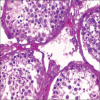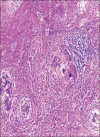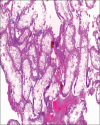Histopathological Pattern of Testicular Lesions in Kano, Northwestern Nigeria
- PMID: 31579369
- PMCID: PMC6771181
- DOI: 10.4103/njs.NJS_44_18
Histopathological Pattern of Testicular Lesions in Kano, Northwestern Nigeria
Abstract
Background: The global distribution of testicular disorders differs conforming with differences in demographic denominators. The diagnostic dictum for these disorders customarily adheres to findings at clinical assessment, relevant imaging, and laboratory evaluation. Histopathological confirmation remains the ultimate for the diagnosis of testicular malignancies and many testicular dysfunctions. The epidemiological review of the histological outcomes among Kano populace, however, is deficient.
Objective: The aim of the study was to analyse histological pattern of testicular lesions in Kano, Nigeria.
Methodology: The study is a 14-year retrospective review of testicular specimens subjected to histology in Kano from January 2003 to December 2016. The variables obtained were the age of patients, laterality, and histological diagnoses. These were collated and analyzed; the findings were presented as mean, patients' age range, and laterality ratio with frequency tables.
Results: Three hundred and forty-three testicular tissues were assessed. The nonneoplastic lesions were 79.2% with patients' age range of 3-90 years. Atrophies and maturation arrests formed 29.4% and 18.0%, respectively. Specimens from the right were more with a ratio of 1.6:1. Neoplastic lesions were 3.5% and patients' age range from 3 to 65 years. Seminomas were the predominant neoplastic lesion and constituted 66.7%. The right testes were more commonly affected and have a ratio of 1.4:1.
Conclusion: This appraisal affirms that testicular lesions could be found across a wide age range and majorities are nonneoplastic. The findings in this study concur with the published African and Asian conclusions.
Keywords: Neoplastic lesion; nonneoplastic lesion; testicular lesions.
Copyright: © 2019 Nigerian Journal of Surgery.
Conflict of interest statement
There are no conflicts of interest.
Figures






Similar articles
-
Testicular Disease: A Clinico-Pathological Report from a Nigerian Tertiary Health Center.Niger Med J. 2023 Jul 2;64(3):307-313. eCollection 2023 May-Jun. Niger Med J. 2023. PMID: 38974059 Free PMC article.
-
Histological pattern of thyroid gland neoplasms in Kano, Northern Nigeria.Niger J Med. 2015 Jan-Mar;24(1):5-11. Niger J Med. 2015. PMID: 25807667
-
The Histopathological Spectrum of Scrotal Lesions in a Tertiary Care Hospital: A Cross-Sectional Study.Cureus. 2024 Jan 22;16(1):e52767. doi: 10.7759/cureus.52767. eCollection 2024 Jan. Cureus. 2024. PMID: 38389620 Free PMC article.
-
[Primary testicular NK/T cell lymphoma: a clinicopathologic analysis of six cases].Zhonghua Bing Li Xue Za Zhi. 2018 Mar 8;47(3):168-171. doi: 10.3760/cma.j.issn.0529-5807.2018.03.004. Zhonghua Bing Li Xue Za Zhi. 2018. PMID: 29534354 Review. Chinese.
-
Spectrum of Extratesticular and Testicular Pathologic Conditions at Scrotal MR Imaging.Radiographics. 2018 May-Jun;38(3):806-830. doi: 10.1148/rg.2018170150. Radiographics. 2018. PMID: 29757721 Review.
Cited by
-
Testicular Disease: A Clinico-Pathological Report from a Nigerian Tertiary Health Center.Niger Med J. 2023 Jul 2;64(3):307-313. eCollection 2023 May-Jun. Niger Med J. 2023. PMID: 38974059 Free PMC article.
References
-
- Rosai J. Rosai and Ackerman's Surgical Pathology. 10th ed. Vol. 1. New York: Elsevier; 2011. Male reproductive system; pp. 1335–6.
-
- Alhaji SA, Abdulkadir A, Sanusi HM. A 15-year pathologic review of testicular and paratesticular tumours in Kano, Northern Nigeria. Niger J Basic Clin Sci. 2016;13:114–8.
-
- Garner MJ, Turner MC, Ghadirian P, Krewski D. Epidemiology of testicular cancer: An overview. Int J Cancer. 2005;116:331–9. - PubMed

